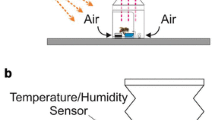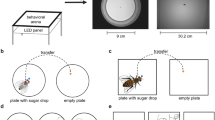Summary
-
1.
The flight duration and distance of flying bees mounted on a roundabout were investigated. The bees were nourished with fructose and glucose (both injected into the abdomen = i), with sucrose (fed = g or injected = i) or with the alcohol sorbitol (mixed with sucrose in a weight ratio 1∶1, fed = g or injected as pure solution).
-
2.
The distances and the duration of the flights were always directly proportional to the quantity of carbohydrates taken up by the bees. Some constants of the linear functions showed significant differences.
-
3.
The bees, on the average, came up to 768 rotations/mg fructose (i). If this performance = 1, then the relative constants for the distance result in the following values: glucose (i) = 0,94; sucrose (g) = 0.73; sucrose (i) = 0.70; the mixture: sucrose+sorbitol 1∶1 (g) = 0.50; sorbitol (i) = 0.23. Differences between glucose and fructose as well as between fed an injected sucrose are not significant. All other differences are significant at the 0.05 level.
-
4.
For fructose the duration of flight amounted to 8 min/mg. The constants of the linear functions related to fructose (=1) are: 0.94; 0.74; 0.73; 0.75 and 0.39 in the above order.
-
5.
With all sugars the bees reached very similar numbers of revolutions per minute. The r.p.m. fell by 1/3 when the bees received sorbitol.
-
6.
R.p.m., distances and the distribution of rest intervals always showed clear relationship to the energy supplying substrates. Injected fructose was very quickly transformed, injected glucose with increasing velocity, fed-sucrose was transformed more quickly than injected sucrose. Sorbitol was transformed slowly, and was utilized poorly in flight metabolism.
Zusammenfassung
-
1.
Es wurde untersucht, wie lange und wie weit Bienen an einem Karussell mit den Zuckern Fructose und Glucose (beide in das Abdomen injiziert = i) mit Saccharose (getrunken = g oder injiziert = i) oder mit dem Alkohol Sorbit (mit Saccharose im Gewichtsverhältnis 1∶1 gemischt verfüttert = g oder in reiner Lösung injiziert = i) fliegen können.
-
2.
Flugstrecken und Flugdauer waren stets den Kohlenhydratmengen direkt proportional, die die Bienen vor dem Flug aufgenommen hatten. Die Konstanten der linearen Funktionen unterschieden sich zum Teil signifikant.
-
3.
Die Bienen erreichten im Mittel 768 Umdrehungen/mg Fructose (i). Setzt man diese Leistung = 1, dann erreichen die relativen Konstanten für den Flugweg folgende Werte: Glucose (i) = 0,94; Saccharose (g) = 0,73; Saccharose (i) = 0,70; Mischlösung Saccharose + Sorbit 1∶1 (g) = 0,50; Sorbit (i) = 0,23. Nicht signifikant sind die Unterschiede zwischen Glucose und Fructose sowie zwischen getrunkener und injizierter Saccharose. Alle anderen Differenzen sind auf dem 0,05-Niveau signifikant.
-
4.
Für Fructose betrug die Flugdauer 8 min/mg. Die Konstanten der linearen Funktionen, bezogen auf Fructose (= 1) sind dann: 0,94; 0,74; 0,73; 0,75 und 0,39 in der oben angegebenen Reihenfolge.
-
5.
Mit allen Zuckern erreichten die Bienen am Karussell sehr ähnliche Umdrehungsgeschwindigkeiten, die Tourenzahlen differieren im Mittel nur um 5%. Die Tourenzahlen (\(\bar \bar V\)) sanken um 1/3, wenn die Bienen Sorbit aufgenommen hatten.
-
6.
Tourenzahlen, Längen und zeitliche Verteilung der Flugpausen zeigten stets deutliche Beziehungen zu den energieliefernden Substraten: Injizierte Fructose wurde sehr rasch umgesetzt, injizierte Glucose mit steigender Geschwindigkeit, getrunkene Saccharose etwas rascher als injizierte, Sorbit wurde nur langsam umgesetzt und im Flugstoffwechsel schlecht verwertet.
Similar content being viewed by others
Literatur
Frisch, K. v.: Über den Geschmacksinn der Bienen. Z. vergl. Physiol. 21, 1–156 (1934).
—: Tanzsprache und Orientierung der Bienen. Berlin-Heidelberg-New York: Springer 1965.
Hocking, B.: The intrinsic range and speed of flight in insects. Trans. roy. ent. Soc. Lond. 104, 223–345 (1953).
Jongbloed, J., Wiersma, C. A. G.: Der Stoffwechsel der Honigbiene während des Fliegens. Z. vergl. Physiol. 21, 519–533 (1935).
Scholze, E., Pichler, H., Heran, H.: Zur Entfernungsschätzung der Bienen nach dem Kraftaufwand. Naturwissenschaften 51, 69–70 (1964).
Tillich, E. M.: Bienentänze und Karussellflüge nach Verfütterung von Saccharose, Maltose und Sorbit. Diss. Graz (1967).
Vogel, B.: Über die Beziehungen zwischen Süßgeschmack und Nährwert von Zuckern und Zuckeralkoholen bei der Honigbiene. Z. vergl. Physiol. 14, 273–347 (1931).
Wenzl, H.: Verdauung und Verwertung von Kohlenhydraten durch Calliphora erythrocephala Meig. Diss. Würzburg (1966).
—: Sorbitdehydragenase bei Insekten. Z. vergl. Physiol. 62, 411–412 (1969).
Author information
Authors and Affiliations
Additional information
Mit teilweiser Unterstützung durch Mittel des Österreichischen Forschungsrates.
Rights and permissions
About this article
Cite this article
Loh, W., Heran, H. Wie gut können Bienen Saccharose, Glucose, Fructose und Sorbit im Flugstoffwechsel verwerten?. Z. Vergl. Physiol. 67, 436–452 (1970). https://doi.org/10.1007/BF00297911
Received:
Issue Date:
DOI: https://doi.org/10.1007/BF00297911




